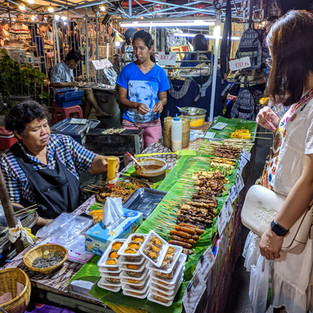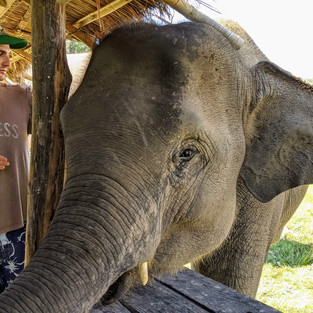Same Same, But Different: Chiang Mai Ten Years Later
- mkap23
- Jan 3, 2020
- 15 min read
Updated: Jan 20, 2020
When we first visited Thailand ten years ago in 2009, we left thinking that it was one of the world’s premier travel destinations—even if it is cliché. We still believe this, maybe even more strongly now. There is a reason that Thailand is often the first stop for those visiting Southeast Asia for the first time. The food is phenomenal and clean, including the scrumptious street food; that alone is worth the trip. It is home to a wide range of places to go and things to do: large modern cities, historic sites, and undisturbed nature, from waterfalls and mountains to secluded beaches and islands. The culture runs deep and rich; it is decidedly different from Western culture, but also not too different that it becomes intimidating for some. The people are ultra friendly, earning the country the well-deserved nickname of the Land of Smiles. It is very safe and easy to get around, and things generally work. And finally—the great draw for backpackers—it is still cheap. The only drawback is that none of this is a secret.
After three weeks in Myanmar, we were looking forward to the easy flow of Thailand. We headed for Chiang Mai, the natural next stop on our planned route along the northern stretch of Southeast Asia; while we had originally planned to travel overland from Myanmar to Thailand through the northern border crossing, we learned that the road through eastern Shan State to get to that border crossing was impassible due to armed militants controlling the area. So, we ended up hopping a flight from Mandalay to Chiang Mai instead; the short one-hour flight seemed to span far more than that, as we went from the occasional stress and uneasiness of Myanmar (see: armed militants above) to the pure laxness of Thailand.

Chiang Mai, meaning “Walled City” (much of the original wall around the Old City is still intact today), was the capital of the Lanna Kingdom, which was eventually absorbed into the Kingdom of Siam in the late 1800s. The Lanna, and Thailand as a whole, was the only one of its Southeast Asian neighbors to never be colonized by the West, avoiding the external conflicts and civil wars that plagued the rest of them for centuries, and from which many are still recovering today. The significance of this never really occurred to us until this trip, when we experienced the sharp differences between these countries and Thailand back-to-back. Without the original setback and oppression of foreign colonization, and the subsequent necessary rebuilding, Thailand has had the chance to flourish in its own image for centuries—something that was stunted for other countries like Myanmar, Laos, and Vietnam, all of whom had their golden eras cut short. This is likely one key reason why Thailand is currently more prosperous than its neighbors, with more established infrastructure, systems, businesses, and overall quality of life, which leads to the same for the traveler. The others are getting there—rather quickly in some cases—but as we’ve seen time and again, rebuilding takes time.
If Thailand is easy, then Chiang Mai is the Big Easy. Chiang Mai is built for lounging. There actually isn’t that much to actively do inside Chiang Mai proper, and that’s what makes it so great. Pretty lantern-filled streets for strolling and quiet wats (Buddhist temples) for contemplating? Check. Garden coffee shops doling out sweet Thai iced teas and strong wifi? Check. Bars with cheap cold Chang beer on tap? Check. Restaurants serving up endless bowls of Khao Soi, the delicious northern Thai coconut curry noodle dish with chicken and topped with fried egg noodle crispies? Check. Massage parlors offering Thai massages that lovingly rip off your limbs and contort your body in ways you never thought possible and never knew you needed? Check. Eating, drinking, and spa’ing—that is Chiang Mai.

Before landing this time around, we were a bit afraid that some of this comfortable, laid back vibe would be lost in the ten years since we’ve been. So what’s changed in the last decade? Turns out, not really all that much, at least from our visitor experience. Chiang Mai is still a relaxing haven, and two of our four days there consisted of just that. Prices are up a bit, but not significantly; by our calculations, it is just regular inflation over time. We paid $20 a night for both of us for a room in a decent guesthouse, but it is still possible to get a dorm bed in a nice hostel for $6-8 per person per night. Previously, a Thai iced tea or a fresh fruit smoothie cost around $1; this time, it was about $1.50—still well within budget to drink several a day, which we did. Massages used to be $4-5 for 60 minutes; now they are $7-8—also still well within budget to get a few of those, too. And, the city is still as popular as ever with Western tourists, especially Americans, though these days, there appeared to be many Chinese tourists, as well. Luckily, since there aren’t many main sites to visit, the crowds felt fairly dispersed among multiple wats and areas of town (except maybe at Doi Suthep, the beautiful large temple overlooking the city, discussed more below).
If anything has changed, it’s the two of us. (Except maybe for our clothes. Somehow, they basically look the same from ten years ago—see photos below. Michael even bought that green Chang shirt at the Chiang Mai night market in 2009, and it is still holding up well after all this time!) The felt experience of our activities and pace has shifted a bit. Ten years ago, we went out on the town a lot more. There was the Muay Thai (Thai kick boxing) match, where we got sufficiently drunk with our Hawai`i and Couchsurfing friends, faked-boxed in the ring after the match, and then all crammed into a tuk-tuk afterward, hanging off of it as we drove around. There was the night out in Nimmanhaemin, a trendy neighborhood of restaurants and bars frequented by both local university students and tourists alike, flowing with beer and playing American pop songs (the Thai love Four Non-Blondes for some reason). And there was New Year’s Eve 2010, when we partied raucously along the Ping River while launching lanterns into the air to celebrate with everyone.
This go-around, there was a lot less drinking, but we did a lot of eating to make up for it! We did go out again in Nimmanhaemin, but this time for Korean fried chicken at a food truck and organic homemade ice cream for dessert (clearly, this area has not lost its title as the trendy neighborhood!). We also spent a lot of time at the weekend night markets, which the Thai call “walking streets,” sampling as much of the high quality and delicious street food as we could. For starters, we tried gyoza, more homemade ice cream (dessert came early and often), sticky rice with a multitude of toppings, including mango and avocado, special Chiang Mai spicy sausage stuffed with chilis and flavored with lemongrass, and lots of meats on sticks. The best deal was “pork milk,” which was a sizable and delicious piece of grilled tender pork on a stick for 5 bhat, or around 18 cents. Then we had dinner.
To avoid becoming completely fat and lazy, we did force ourselves to stop eating and visit a few of the many temples in Chiang Mai. We had visited the unique Chedi Luang on our previous trip, so we went back to stage the fun then-and-now photos (above), and, more interestingly, to participate in a “Monk Chat.” These information sessions and language exchanges only began several years ago (they did not exist in 2009), and are conducted by monks-in-training, who answer visitors’ questions about Buddhism and life as a monk while getting the opportunity to practice their English. Our chat included just the two of us and a Portuguese couple talking to “Damon,” a 19-year-old monk from a village just outside of Chiang Mai.
We learned that studying at a temple in Thailand is typically not a lifetime requirement. At different stages in a Thai man’s life, it is expected that he will spend at least a few weeks living at a temple, studying Buddhism and meditation, in order to get in touch with their religion and culture. For most, this is only a temporary visit. Damon came to Chedi Luang when he was about 12-years-old, and so far, has enjoyed it and chosen to stay. Raised in a poor rural family, studying to be a monk has given him an opportunity to obtain a good education that he otherwise may not have been able to get (his English was excellent). Now that he is close to wrapping up his studies, he is thinking about whether he wants to continue on to become a full blown monk, or attend a secular university. We could help him with his English, but could offer no advice on this important decision.

If he does continue as a monk, his way of life would become more restricted as he advances. As a novice, he currently “only” has to abide by ten overarching rules, called the Ten Precepts. Many are similar to the Ten Commandments, including no killing, no stealing, etc…easy stuff (we hope). But then some are much more challenging in today’s modern lifestyle, including no eating after 12pm, no sleeping on a high or luxurious bed (monks sleep on the floor), and no sexual misconduct or interactions whatsoever. Then, as a full monk, many more rules are added to these, all meant to guide a life as simple and humble as possible. All told, there are 227 rules, providing exacting details about everything from the maximum allowable size of a monk’s living quarters, how and from whom they can receive a new robe, and the ways in which they are permitted to or prohibited from interacting with women (Damon had to be far enough away from Karen in the above photo, even though he offered to take the photo). Moses would still be up on Mount Sinai collecting tablets today if there were 227 commandments.
Beyond the insight into Damon’s life, the most interesting and relatable part to us was our discussion about meditation. He and his fellow students take meditation classes in the morning in order to clear their minds before they go to school (school consists of “regular” studies such as math and science, as well as classes on Buddhism). To us, this seems like an ideal way to start the day, and we can only imagine how much more we would have absorbed and learned in school if we had first meditated every morning. Damon told us that when he gets angry, he goes off and meditates for awhile before reacting—also a very wise move for someone his age; we imagine that given this practice, he does not really get angry much anymore. The monk chat left us wanting to learn more about meditation practice, a foundational part of Buddhism that can be beneficially applied outside the religious practice.

After our chat with Damon, we visited Wat Sri Suphan, an old temple hailing from the 1500s, but more recently known as the Silver Temple because in 2008, they started to cover the entire thing completely in silver and other silver-looking metals, such as aluminum and nickel, to honor the silversmiths in the village. It is spectacular on the outside, especially at night, but even more interesting on the inside: unlike a traditional temple, which often showcases images of Buddha’s life and his disciples, the Silver Temple features modern drawings inside, including a map of the world with GPS coordinates covering the floor, and the evolution of man from ape to human embossed on one of the walls (all in silver-colored metal, of course). Ironically, this modernity gets a bit lost in the fact that women are not allowed inside (which is strange, since almost all other temples in Thailand do allow women, so long as they are appropriately dressed and covered up); Michael and our friend Drew had to go in without their brides.
Speaking of Drew, our Chiang Mai visit this time around was made extra special because we got to spend a good amount of time with Drew and Leslie, our friends from Hawai`i. Drew, an experienced tour guide from the world famous Princeville Ranch Adventures zipline tour on Kaua`i, and more recently at a lesser known, fledgling business called Adventures by Disney, was in town because he and Leslie are starting their own international travel company, called True Adventures (we think; we spent half our time with them brainstorming business names, and as of publication time, this is where they’ve landed!). Their first tour will be in Thailand, so they were in country for a few months to plan and put together the itinerary. As another sign of how we’ve changed over the past decade, in 2009, our conversations with friends in Thailand were about whether we could really fit five people in one small studio apartment with just one futon bed (we did!), while downing dozens of beers; this time, we talked to our friends about Thai business models, marketing strategies, and which company name is best for SEO (search engine optimization), while sipping butterfly pea tea. Geez, getting old sucks.

In any case, this is how we found ourselves going from lounging around and sipping Thai iced teas to taking a mud bath with elephants. Drew and Leslie had visited a number of the many elephant sanctuaries in the hills around Chiang Mai on a familiarization trip (or a “fam” trip, as they say in the biz), to see which one they want to include as part of their family tour. When we met up with them, they hadn’t found the right one yet—one was too commercial, one was excellent but required too much hiking and was too far away, one kept their elephants in pens—so they were still on the search. We went with them to visit the Karen Hill Tribe elephants, a highly regarded local outfit who comp’ed Drew and Leslie, while generously offering the two of us half price for the tour, as “True Adventure Associates.” We were so excited to play with elephants!—er, we mean, to do research and “fam” ourselves.
Elephant tours have also changed in the last ten years—a lot. We admit that in 2009, we rode on the elephants as part of a multi-day trek to the surrounding hill tribes. That was just what you did. Because the elephants used to be used as pack animals for logging before the practice was banned, many people assumed that a second career shuttling around a few tourists wouldn’t be so bad. Now, there is a lot more information on why riding elephants is actually not healthy for them either and just a different form of abuse. The wide distribution of this information, coupled with the rise of the eco-conscious traveler, have made most tour companies adapt their approach. They used to advertise trips to ride the elephants; today, they proudly advertise not riding them.

Karen Hill Tribe was one of these latter elephant sanctuaries. They had four rescued elephants at their sanctuary: one female in her fifties, one pregnant female (she’ll be pregnant for two years!), one male, and one rambunctious five-year-old “tween.” The first thing we noticed when we arrived was that the elephants were roaming free, as they came happily bounding over to our truck as we pulled up. They are used to being fed by tourists, so they seemed just as excited for us to arrive as we were to see them.
Even though feeding, petting, and hanging out with elephants is now a common tourist activity across Thailand, it was still a true treat to be able to spend time in this way with such gentle giants. First, we fed them bananas and sugarcane to get them comfortable with us. If anything, we were the ones who were a bit uncomfortable—they are big animals with big mouths (though the Asian elephant is far smaller than the African species), and you don’t want to be standing where they can’t see you, lest you get run over! They also love food (similar to us in Thailand, they eat for about 18 hours a day), and are not ashamed to come over to ask you for more. They would nudge us with their trunk for more fruit, or, if we had a snack in our hand, they often reached out and straight up grabbed it. Their trunks are long, so sometimes their pokes came out of nowhere and surprised us! Trunks are so weird up close, no matter how long you stare at it; it’s like a nose-hand.
After the feeding, came the elephant spa treatment (see, the elephants like living in Chiang Mai, too). We started with a mud bath, which mostly consisted of us throwing mud on each other while trying not to get pinned underwater as the elephants rolled around in the shallow mud pit. It was incredibly fun, but it was also important for the elephants, as the daily mud spa helps them cool off in the hot Southeast Asian sun. After the mud bath, we guided the elephants to a watering hole, where we all washed off. The elephants seemed to have a great time, even though the water we splashed on them felt measly relative to their body size.

After the elephants, the tour continued: we had lunch, made tamarind “medicine balls” for the elephants, hiked to and swam at a nice waterfall, and then took a fairly-pathetic bamboo raft ride down the river (which has decidedly not changed or improved over the last ten years, since we remember thinking the same thing then…). As we drove back to the city, we assessed the tour with Drew and Leslie to fulfill our role as Associates. Overall, we all thought the experience was positive, mostly because the main draw—the elephants—were social, well-behaved, free-ranging, and absolutely adorable. The members of the Karen Hill Tribe who run the sanctuary were also really nice, very authentic, and well-intentioned. Our main critique was that they did not offer a whole lot of information about the elephants or the tribe itself. One of the benefits of going with a tour is usually to learn more about a place or activity; however, we didn’t get to learn much about the elephants’ history or their lives in general. There were multiple gaps of time when we were not playing with elephants or doing anything at all (they are free ranging, after all, so they were not always around), which would have been a good chance to provide some of this education. Instead, we just sat around awkwardly or even napped, waiting for the next item on the itinerary (which was often also unknown to us). Finally, the lunch, which was just a tray of Pad Thai, left much to be desired in both presentation and selection. We all felt that this was a missed opportunity to give guests a small taste of Karen tribe culture, which few know about; instead, they served us the spaghetti and meatballs of Thai food that is the one Thai dish everyone eats in America.

The lack of information on this tour would not necessarily be a problem with a great tour guide like Drew stepping in to provide that narrative, except that he can’t actually guide the tour himself. By law, he is required to have a local Thai guide (which we support and appreciate). Therefore, they will be hiring their own local tour guides, as well as a Destination Management Company (DMC) to handle the logistics. A DMC is the local company that bridges the gap between tour companies who bring in the clients and the web of local bureaucracy located at the tour destination. The challenge is to find the right DMC and the right guides who are knowledgeable and who speak English, who can then make a good tour a great one. With Drew and Leslie’s feedback, guide training, and additional magical touches, the Karen Hill Tribe experience can definitely get there and become a highlight for guests; we know it was for us.
The next day, we continued to help improve the Thailand itinerary (can we get a promotion up from Associate already?!). We decided to go up to Doi Suthep, a sacred wat on top of a mountain just outside of town, overlooking the city. The two of us had visited this pilgrimage site ten years ago, but Drew and Leslie had never been before and wanted to see if, when, and how it most appropriately fit on their tour. Most people drive up to the top, starting at the base of the steps leading up to the temple. We decided to add some intrigue and first take a short trail to another temple lower down on the mountain, before then riding up the rest of the way. This turned out to be a good choice.

The trail, called the Monk’s Trail, was nice and short, taking about an hour to hike through a lush forest with a pleasant stream and bamboo grove. But it was the temple at the end of that trail, Wat Pha Lat, that truly caught us by surprise and took our breath away. None of us had ever heard of this place before, and Lonely Planet doesn’t even mention it, so we were all a bit taken aback by how beautiful it was. Set in a forested valley along a stream with a few small waterfalls, the temples were simple structures in harmony with their surroundings; one stupa had bright green moss growing all over it, giving it an even more whimsical and forested feel. The lush grounds hid many nooks and crannies under the shade of bamboo or next to the trickling of passing water, where one would want to sit and read a book for hours. And since it was fairly hidden from the main road to Doi Suthep, there were not a lot of visitors around, making it all the more peaceful. It was exactly what you might envision if you were designing the perfect place to retreat and meditate. Wat Pha Lat quickly became one of our favorite temples in Southeast Asia, a land known for its amazing temples.
After taking it all in, all of us were a little hesitant to complete the journey up to the much more crowded Doi Suthep. But having lingered at Wat Pha Lat for awhile, we arrived at the top of the mountain toward the end of the day, so it ended up not being too jammed. After snapping more now-and-then photos at the naga entrance (dragon serpents that guard the temple), we climbed the 300 steps to the top. The evening turned out to be another great and unexpected experience of repeated favorites and new experiences. Doi Suthep is great at incorporating traditional ceremonies and rituals into the visitor experience, Buddhist or not. In this spirit, we all participated in a blessing by a monk, receiving from him the pure white thread tied around our wrists, before circumnavigating the main gold stupa three times while chanting and offering a lotus flower to pay our respects. We then joined a group of sunset watchers at a high overlook to see the day’s last light dip over the old walled city. And finally, once the sun went down, we listened to the monks at their daily 6pm chanting, watching the gold stupa change colors while feeling the reverberations of their prayers. Neither Doi Suthep nor Wat Pha Lat were on the itinerary for True Adventures, but after the magical day we had, we all agreed that the hike, the forest temple, the sunset view, the temple ceremonies, and the monk chanting were awesome, and should be included. True Adventures’ family-friendly, affordable luxury trip of a lifetime launches in 2020, so book your next vacation with them now! (See www.trueadventuretours.com—promoting to our very wide audience here.)
Before we temporarily parted ways with Drew and Leslie (we would meet up with them again in Vietnam in a month!), we did not miss the opportunity to lazy around Chiang Mai some more. A few more mango-passionfruit smoothies, full-body massages, and freshly-made pasta servings later, we all planned to come back to Chiang Mai soon, Drew and Leslie to run their tour, and we to do nothing—and love it.
Karen & Michael
Chiang Mai, Thailand, November 16-20, 2019





































































Comments